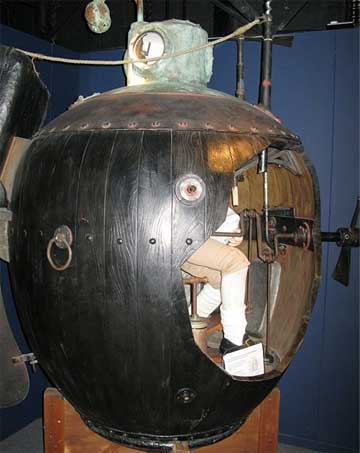
During the American Revolutionary War, David Bushnell invented the Turtle, the first military submarine, to counter British naval power. Designed to carry one operator, it aimed to attach explosive mines to enemy ships. The Turtle’s 1776 mission against the HMS Eagle was unsuccessful, yet it marked the first use of underwater warfare, pioneering submarine technology.
The Turtle was a small, single-person submersible, shaped like a large clam, with enough space inside for one operator. Constructed from wood, reinforced with iron, and sealed with pitch for waterproofing, it was designed to function underwater for short periods. Bushnell’s design included a hand-operated screw propeller, the first of its kind, allowing the operator to maneuver it forward, backward, and even to change its depth. It also had a ballast tank that could be filled to submerge the craft and emptied to provide buoyancy, making it a groundbreaking vehicle for its time. The craft was controlled using a system of valves and levers, which allowed for precise adjustments in buoyancy and direction.
The Turtle’s weapon was a charge with a timed fuse designed to be attached to the underside of an enemy ship. Bushnell referred to this weapon as a “torpedo,” though it differed greatly from what we consider torpedoes today. Instead, it was essentially an underwater mine—the first of its kind—intended to explode after a short delay, damaging the hull of the targeted ship. If successful, such a device could threaten even the largest British vessels, providing the Americans with a means of countering the British blockade.
On the night of September 7, 1776, the Turtle embarked on its first mission, targeting the British flagship, the HMS Eagle, anchored in New York Harbor. The submarine was piloted by Sergeant Ezra Lee, who had been trained to operate the unique vessel. Lee managed to maneuver the Turtle undetected to the Eagle’s hull. However, as he attempted to attach the explosive device to the ship, he encountered difficulties. The hull was reinforced with copper, which prevented Lee from securing the mine effectively. After repeated attempts, he was forced to abandon the mission and retreat.
Although the mission was unsuccessful, the Turtle’s attack marked the first documented attempt at underwater warfare. The submarine was later deployed for other missions but faced challenges in implementation and was eventually lost when the British sank the ship transporting it. Despite these setbacks, Bushnell’s invention demonstrated the potential for submarines and underwater weaponry, concepts that would be further developed in the centuries to follow. The Turtle remains a significant milestone in military history, representing early American ingenuity and resilience in the face of overwhelming British power.
 >
>